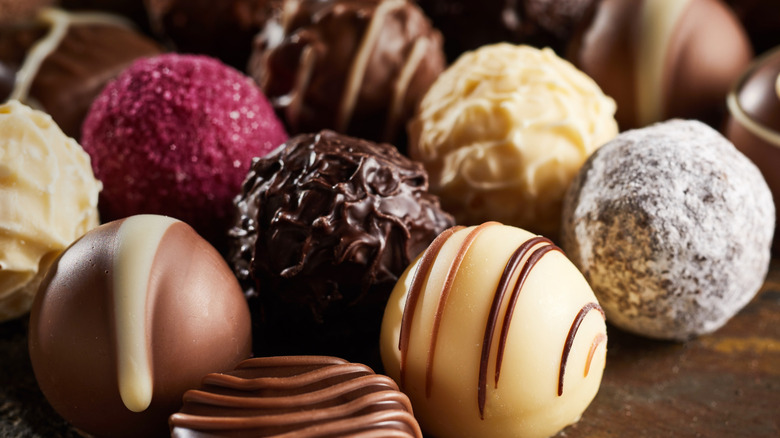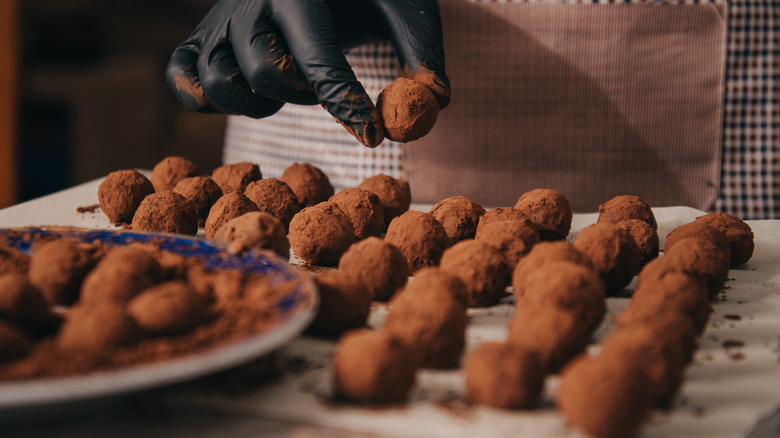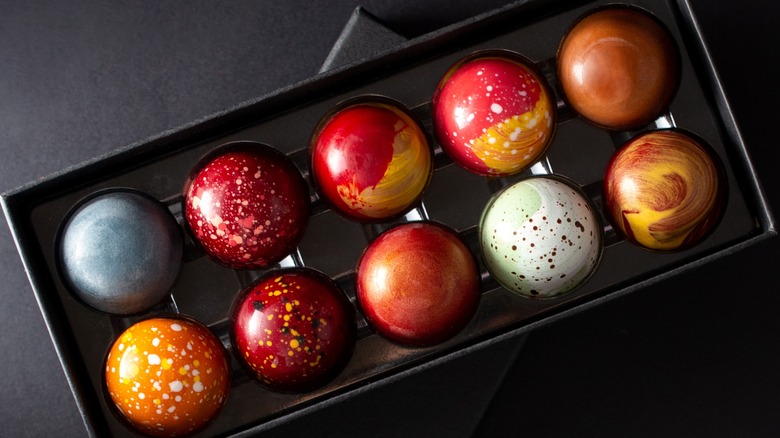The Difference Between Truffles And Bonbons Is All In The Filling
Eating a handmade bonbon or truffle is a real feast for the senses: The smell of fresh chocolate, the taste of rich ingredients, and the sound of the light crunch as you bite through a hard shell into a soft filling.
Two incredibly similar-looking candies, truffles and bonbons are generally made with a chocolate casing, with fillings that can range in flavor thanks to the chocolatier's creative ideas. Both can be bought in specialty chocolate shops and grocery stores or made at home, and are often beautifully decorated. Whether brushed with edible paint, topped with gold flakes, or drizzled with a contrasting chocolate or caramel, in the right hands truffles and bonbons can be miniature pieces of art.
And while the two chocolate treats share a lot of similarities, there is one major difference between the two that can set them apart: the filling
Truffles: Round balls of deliciousness
Just like the expensive and delicious fungi that share the same name, chocolate truffles are something to be savored. With a core made from ganache (blended chocolate, cream, and perhaps a little butter), sweets never tasted so good. Variations on the delicious bite can also include coffee, fruit, nut, and essence flavorings (think Amaretto or vanilla).
While their appearance may be simple enough, there is a science behind making truffles; the chocolate and cream must be well blended, or the truffle will have an oily quality as it is eaten. After the ganache is made, it is formed into a ball and then rolled in cocoa powder, which helps the ganache to hold its shape as well as make it easier to eat. It also gives the treat an appearance more closely resembling the dark, unevenly shaped truffle found in the woods of France. However, an optional layer of hardened chocolate can be used on a truffle. The ganache simply needs to be coated with tempered chocolate that is allowed to dry before enjoying.
While truffles are available for cheap on the mass market, expect the inexpensive candy to have more sugar than the truffles made in artisanal shops. They also may contain chemicals, waxes, and stabilizers for added shelf life.
Bon bons: Slightly different round balls of deliciousness
While similar to a chocolate truffle, a bonbon is a little more elegant, often with a multi-layer filling and a colorful chocolate shell. A bonbon is a distinctive kind of candy generally made with a center of fruit, nougat, ganache, caramel, or nuts and coated in chocolate. Some even have decorative, edible paint to add an extra level of beauty or contain layers of ganache, fruit, and nuts. Like truffles, bonbons trace their history back to France where they were given their name, coming from the word "bon," meaning "good." Unlike a round truffle, a bonbon is tempered chocolate molded around the soft filling and formed to have a rounded top and a flat bottom.
To create a bonbon, the chocolate shell has to be properly done, or the bonbon will be difficult to eat. First, a mold is coated with tempered chocolate before the filling is inserted. If the chocolate layer is too thick, the bonbon may not come out of the mold easily, but if the shell is too thin, then it won't hold the filling. Additionally, the chocolate shell does more than just add another chocolate element to the treat. It actually helps to preserve the filling by keeping the air out. Another difference between a truffle and a bonbon is that the latter's filling doesn't have to be solid. Due to the hard shell, a bonbon can contain a liquid filling, such as a raspberry purée or a cherry soaked in alcohol.


